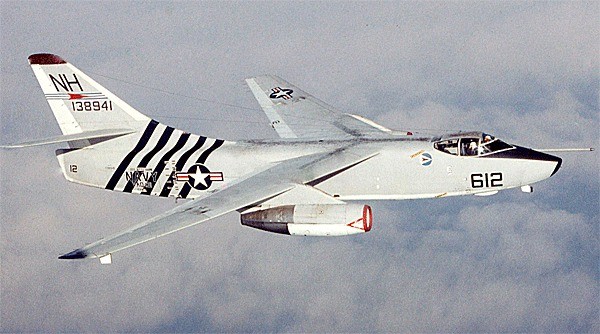The once familiar whine of Whidbey Island Naval Air Station’s first permanently assigned jet bomber may once again be heard roaring its way over Oak Harbor skies.
An A-3 Skywarrior jet is expected to fly in from Van Nuys, Calif., sometime in the next few weeks to become part of a static display on the corner of Langley Boulevard and Ault Field Road near the base’s main gate.
And you can be sure that waiting there to greet it will be members of the Whidbey A-3 Skywarrior Memorial Foundation, the nonprofit group responsible for the aircraft’s return.
“That’s when you’ll know you are back in whale country,” said Bill Young, a retired Navy captain who flew the A-3 out of Whidbey and over Vietnam.
Weighing in at 82,000 pounds when fully loaded and 73 feet long, from nose to tail, the aircraft earned the honor of becoming the Navy’s largest jet ever to operate off an
aircraft carrier. It also earned it the affectionate nickname among flight personnel as the “whale.”
Its size and heft may give an impression of ungainliness, but the A-3 was no slug. In fact, it was one of Navy’s fastest aircraft without afterburners, Young said.
“An F-4 would have to go into afterburners in order to keep up with us,” he said. “It was one fast-moving aircraft.”
The widespread respect the jet earned among pilots and maintenance crews alike is largely why Young and many other foundation members have spent more than a year working to secure an A-3 for display in Oak Harbor.
Confirmation that their effort was a success came this summer when officials from the Naval Aviation Museum in Pensacola, Fla., informed the group it would get one of several planes being used by Raytheon, a private defense technologies firm under contract with the Navy, at their Van Nuis facility.
“Everybody was ecstatic,” said Bill Burklow, an association member and a retired Navy senior chief who once worked on A-3s.
The majority of Skywarriors operated out of Whidbey Island from 1957 to 1968. Of the seven original commands at NAS Whidbey, most were transferred to bases in California or were decommissioned. Several survive today, however, and are back on the island. VAH (heavy attack) 2, the Royal Ramparts, and VAH-4, the FourRunners, now operate as the VAQ (electronic warfare) 132 Scorpions, and the VAQ-131 Lancers.
VAH-10, the Vikings, never left the island. In 1971 it transitioned into VAQ-129. Commands that flew A-3s out of other facilities but now at NAS Whidbey include VAQ-130, 133, 134, and 135, along with VAW-13, VQ-1, and VQ-2.
While originally designed to deliver nuclear weapons during the Cold War, the A-3 was used for a wide variety of missions, from a bomber and in-flight fuel tanker to an electronics and photography platform. It was officially retired from Navy service in 1991.
According to Burklow, the specific plane destined for Oak Harbor has always been used as a test aircraft and was never stationed on Whidbey. Apparently, it once donned a large bulbous and black nose section filled with high-tech electronics, however, earning it the handle “Snoopy.”
Getting the jet to Whidbey, which will only be on loan and remain under federal government ownership, was not cheap. The final cost is still under negotiation but is expected to be $50,000 to $70,000, Burklow said. That covers everything from the exorbitant price of jet fuel to flight inspections and the pilot’s time to fly the plane here from California.
So far, the organization has collected about $90,000 in donations, grants and pledges, with about 75 percent of it coming from local sources. Judging by its contribution, the community seems to want the A-3 home nearly as much as the association, said Burklow, with a smile.
The group is still looking for more money, however, as the aircraft’s arrival this month is only the first of a three-phase project. Once it’s here, the jet will be reconfigured into a bomber configuration and then readied for placement on a pedestal, much like the Prowler and Intruder on display at the corner of Highway 20 and Ault Field Road.
The static display will serve as a memorial to those who flew the A-3 Skywarrior, those who perished in the aircraft, and those who provided the support for the crews and their missions. It is believed that 251 people were killed while operating the Cold War era jet. The hope is to have the memorial in place before the end of 2011.
While it appears the community is eager for the return of the Skywarrior to Whidbey Island, it will be particularly momentous for Young. It’s the same bird that kept him safe over countless missions in Vietnam — they shared more than a few close scrapes together — and earned a special place in his heart.
“It’s been a great airplane and done a lot of great things for a lot of people,” Young said. “One of my mottos is ‘whale forever.’”
For more information or to donate, visit the memorial foundation’s website at www.a3skywarriorforwhidbey.org.



